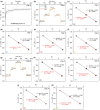PHAIR: a biosensor for pH measurement in air-liquid interface cell culture
- PMID: 33568708
- PMCID: PMC7875988
- DOI: 10.1038/s41598-021-83189-x
PHAIR: a biosensor for pH measurement in air-liquid interface cell culture
Abstract
In many biological systems, pH can be used as a parameter to understand and study cell dynamics. However, measuring pH in live cell culture is limited by the sensor ion specificity, proximity to the cell surface, and scalability. Commercially available pH sensors are difficult to integrate into a small-scale cell culture system due to their size and are not cost-effective for disposable use. We made PHAIR-a new pH sensor that uses a micro-wire format to measure pH in vitro human airway cell culture. Tungsten micro-wires were used as the working electrodes, and silver micro-wires with a silver/silver chloride coating were used as a pseudo reference electrode. pH sensitivity, in a wide and narrow range, and stability of these sensors were tested in common standard buffer solutions as well as in culture media of human airway epithelial cells grown at the air-liquid interface in a 24 well cell culture plate. When measuring the pH of cells grown under basal and challenge conditions using PHAIR, cell viability and cytokine responses were not affected. Our results confirm that micro-wire-based sensors have the capacity for miniaturization and detection of diverse ions while maintaining sensitivity. This suggests the broad application of PHAIR in various biological experimental settings.
Conflict of interest statement
The authors declare no competing interests.
Figures










Similar articles
-
Needle-type ultra micro silver/silver chloride reference electrode for use in micro-electrochemistry.Anal Sci. 2005 Aug;21(8):907-12. doi: 10.2116/analsci.21.907. Anal Sci. 2005. PMID: 16122159
-
An electrochemical approach to monitor pH change in agar media during plant tissue culture.Biosens Bioelectron. 2007 May 15;22(11):2718-23. doi: 10.1016/j.bios.2006.11.009. Epub 2006 Dec 18. Biosens Bioelectron. 2007. PMID: 17178219
-
Multi-analyte biochip (MAB) based on all-solid-state ion-selective electrodes (ASSISE) for physiological research.J Vis Exp. 2013 Apr 18;(74):50020. doi: 10.3791/50020. J Vis Exp. 2013. PMID: 23628944 Free PMC article.
-
Microfabricated reference electrodes and their biosensing applications.Sensors (Basel). 2010;10(3):1679-715. doi: 10.3390/s100301679. Epub 2010 Mar 2. Sensors (Basel). 2010. PMID: 22294894 Free PMC article. Review.
-
Micro-fabricated electrochemical chloride ion sensors: From the present to the future.Talanta. 2020 May 1;211:120734. doi: 10.1016/j.talanta.2020.120734. Epub 2020 Jan 13. Talanta. 2020. PMID: 32070599 Review.
Cited by
-
Integrated Mini-Pillar Platform for Wireless Real-Time Cell Monitoring.Research (Wash D C). 2024 Jul 24;7:0422. doi: 10.34133/research.0422. eCollection 2024. Research (Wash D C). 2024. PMID: 39050822 Free PMC article.
References
Publication types
MeSH terms
Substances
LinkOut - more resources
Full Text Sources
Other Literature Sources

